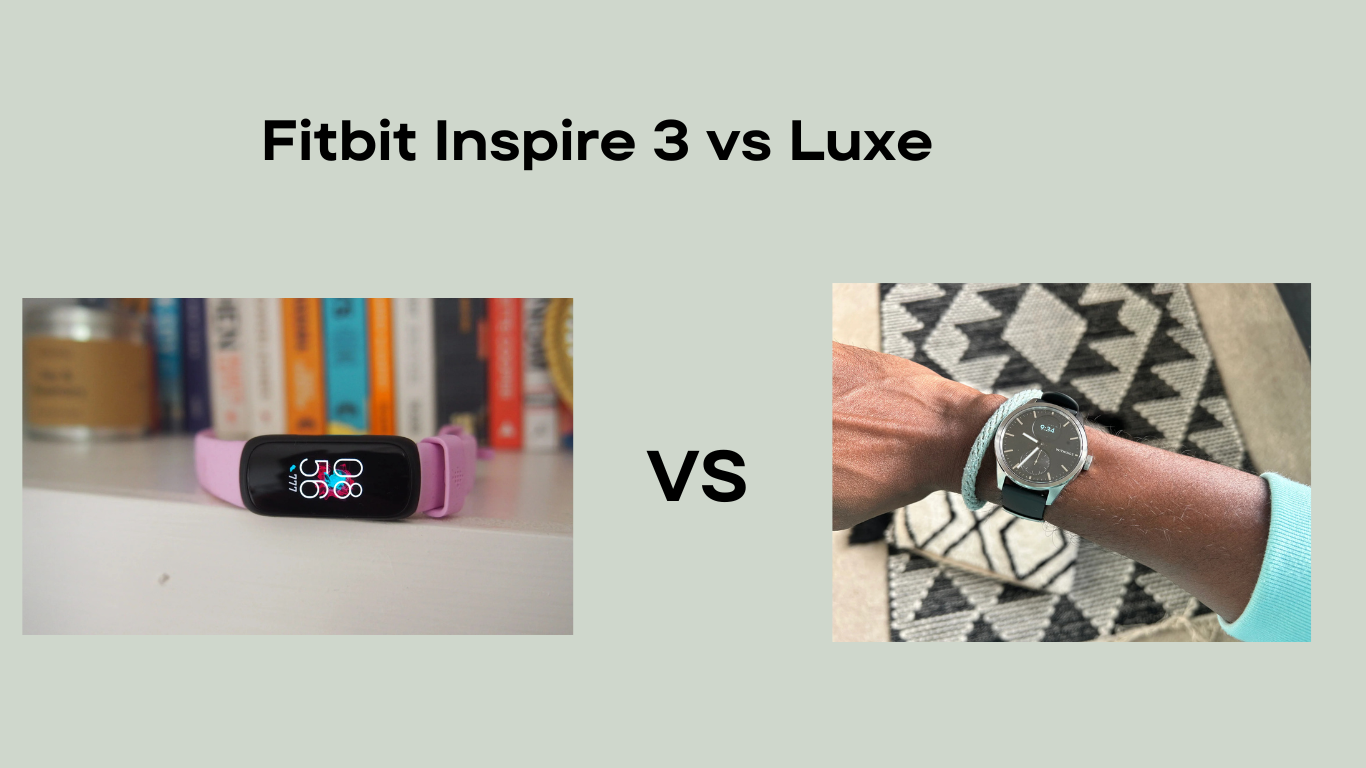The Quest for Optimal Health Tracking: Interpreting the Nuances
Fitness enthusiasts are continuously looking for gadgets that can complement their active lifestyles and offer deep insights into their overall health. Fitbit, a market leader in fitness trackers, has continuously pushed the envelope of innovation by providing a wide variety of products that are customized to each person’s specific needs. This article explores the nuances of two such products, the Fitbit Luxe and the Fitbit Inspire 3, illuminating their unique features, capabilities, and suitability for different lifestyles.
Table of Contents
Harmonizing Design and Function for Aesthetic Appeal
One of the primary considerations when selecting a fitness tracker is its ability to blend seamlessly with one’s personal style. The Fitbit Inspire 3 embodies a sleek and minimalist design, appealing to those who prefer a more understated appearance. Its lightweight construction and interchangeable bands ensure a comfortable fit, making it an ideal companion for daily wear. On the other hand, the Fitbit Luxe exudes sophistication with its stainless steel case, elevating its aesthetic appeal and rendering it suitable for a wide range of occasions, from casual outings to professional settings.
While the Fitbit Inspire 3 boasts a monochrome touchscreen display, providing a straightforward interface for users prioritizing essential functionalities, the Fitbit Luxe takes visual experiences to new heights with its vibrant color AMOLED display. This design distinction caters to diverse preferences, allowing users to choose a wearable that aligns with their aesthetic sensibilities and lifestyle requirements.
Comprehensive Health Monitoring: Empowering Holistic Well-being
Both the Fitbit Inspire 3 and the Fitbit Luxe excel in comprehensive health and fitness tracking, offering features such as heart rate monitoring, step tracking, and in-depth sleep analysis. However, the Fitbit Luxe takes a stride further by incorporating advanced measures into its arsenal, including stress management features and skin temperature change tracking. These additions broaden the Fitbit Inspire 3’s holistic health monitoring capabilities, providing users with a deeper understanding of their overall well-being by offering insights into stress levels and skin temperature fluctuations, both of which contribute significantly to one’s health and fitness journey.
Innovative Technologies: Enhancing the Experience of Luxury
The Fitbit Luxe distinguishes itself through the integration of cutting-edge technologies that greatly enhance its comprehensive health monitoring capabilities. Notably, the device features on-wrist EDA (electrodermal activity) detection, a pioneering technology that aids in stress management. Additionally, the Fitbit Luxe boasts a more advanced sleep tracking system and SpO2 monitoring, features that are notably absent from the Fitbit Inspire 3. This unique combination of advanced features positions the Fitbit Luxe as a superior solution for users seeking in-depth health insights, offering a comprehensive picture of their well-being through the combination of EDA sensing for stress management and the advanced sleep tracking system with SpO2 monitoring.
Battery Endurance and Connectivity: Striking a Balance
When it comes to battery life, the Fitbit Inspire 3 emerges as the clear winner, boasting a longer runtime on a single charge compared to the Fitbit Luxe. Both devices, however, maintain Bluetooth connectivity for seamless synchronization with smartphones. The Fitbit Luxe possesses a unique advantage in the form of its built-in GPS capability, enabling more accurate activity tracking independent of a paired smartphone. This feature enhances convenience and precision during workouts or outdoor activities by providing real-time tracking capabilities without relying on the smartphone’s GPS, a functionality absent from the Fitbit Inspire 3. Thus, while the Fitbit Inspire 3 offers extended battery life, the Fitbit Luxe’s incorporation of built-in GPS increases its utility for users who value precise and independent activity tracking.
Value Proposition: Aligning Functionality with Affordability
The Fitbit Luxe is positioned as a premium option, offering enhanced functionality and a stylish aesthetic. In contrast, the Fitbit Inspire 3 presents a more affordable alternative without sacrificing crucial tracking features. This distinction accommodates users with diverse tastes and priorities. Individuals seeking a balanced blend of price and core fitness tracking capabilities may gravitate towards the Fitbit Inspire 3, while those seeking an upgraded experience with advanced features and a luxurious design may find the Fitbit Luxe more appealing. Ultimately, the decision between the two devices is contingent upon personal preferences, lifestyle requirements, and the desired balance between functionality and affordability.
Specialized Features: Tailoring to Individual Needs
While the Fitbit Inspire 3 provides a solid foundation for fitness tracking capabilities, the Fitbit Luxe and its counterpart, the Ink’dy, outshine it by incorporating specialized features. These include EDA sensing for stress management and enhanced sleep tracking tools, further augmenting their health monitoring prowess. Like the Fitbit Luxe, the Ink’dy prioritizes comprehensive health insights over mere activity tracking. This parallel underscores Ink’dy’s commitment to providing users with a holistic understanding of their well-being, aligning with the Fitbit Luxe’s emphasis on advanced health indicators and enhanced tracking tools. Consequently, both the Fitbit Luxe and the Ink’dy stand out for their ability to offer users a more in-depth perspective on their health beyond basic fitness monitoring, a feature conspicuously absent from the Fitbit Inspire 3.
Weighing the Pros and Cons: A Comprehensive Evaluation
To aid in the decision-making process, let us delve into a comprehensive evaluation of the pros and cons associated with each device:
Fitbit Inspire 3:
Pros:
- Affordability: Offers a budget-friendly option without compromising core tracking features.
- Core Fitness Tracking: Provides reliable basic fitness tracking, including heart rate monitoring, step tracking, and sleep analysis.
- Comfortable Design: Boasts a sleek, minimalist design with customizable bands for comfortable everyday wear.
- Extended Battery Life: Offers a longer battery life compared to the Fitbit Luxe, providing extended usage on a single charge.
Cons:
- Basic Features: Lacks advanced health metrics like stress management tools and skin temperature variation tracking found in the Fitbit Luxe.
- Limited Display: Features a monochrome touchscreen, lacking the vibrant color display of the Fitbit Luxe.
- No Built-in GPS: Relies on a paired smartphone for GPS functionality, unlike the Fitbit Luxe.
Fitbit Luxe:
Pros:
- Premium Design: Showcases a premium stainless steel case, suitable for casual and formal settings, elevating its aesthetics.
- Advanced Health Metrics: Introduces EDA sensing for stress management and advanced sleep tracking with SpO2 monitoring.
- Vibrant Display: Features a color AMOLED display for vivid visuals and an enhanced user experience.
- Built-in GPS: Offers built-in GPS for accurate activity tracking without the need for a paired smartphone.
Cons:
- Higher Price Point: Positioned as a premium option, making it more expensive compared to the Fitbit Inspire 3.
- Shorter Battery Life: Offers a shorter battery life compared to the Fitbit Inspire 3, requiring more frequent charging.
- Potential Style Over Substance: While stylish, some users might find its premium design less suitable for intense workouts or rough use.
Conclusion: Tailoring the Choice to Your Lifestyle
In the end, the choice between the Fitbit Inspire 3 and the Fitbit Luxe comes down to personal preferences and priorities. The Fitbit Luxe appeals to those who seek a premium experience that blends design, advanced health indicators, and ease of use. On the other hand, the Fitbit Inspire 3 caters to individuals who prioritize essential fitness tracking capabilities without sacrificing affordability. Within their respective pricing ranges, both devices remain dependable, providing consistent and trustworthy fitness tracking capabilities. This assurance enables users to confidently choose a Fitbit wearable that complements their unique lifestyle and health goals. Fitbit offers alternatives tailored to diverse needs, empowering users to make informed decisions aligned with their specific objectives and preferences, whether they value comprehensive health information and fashionable design or emphasize vital fitness tracking at a more accessible price point.

